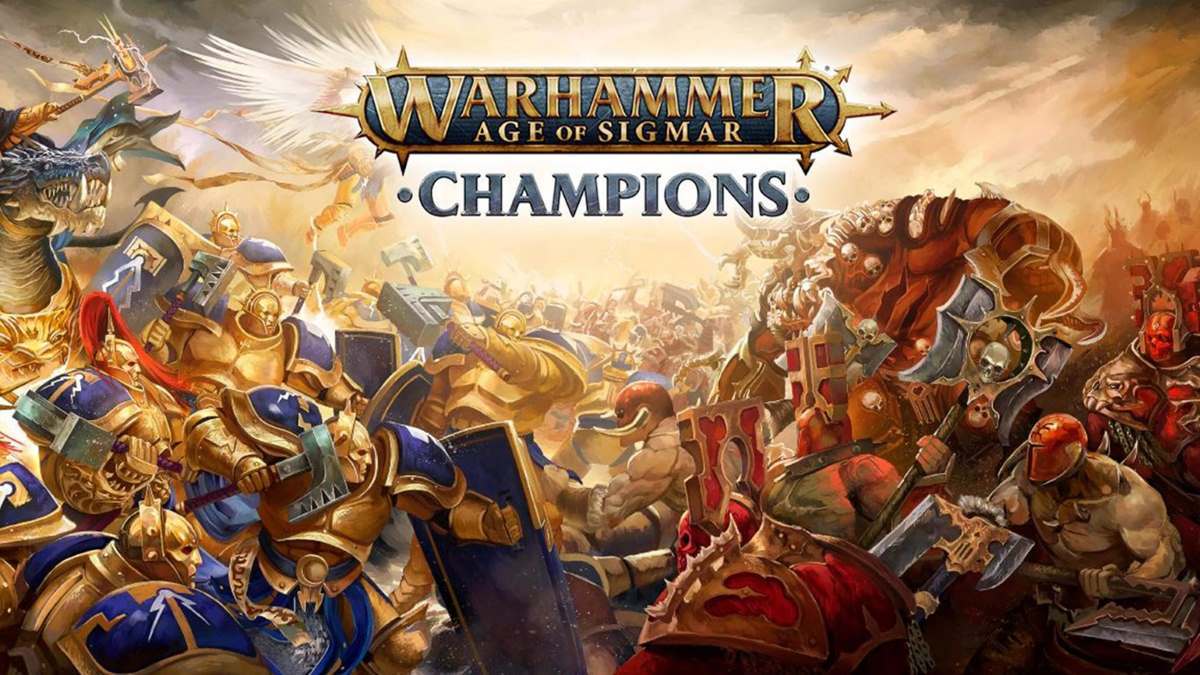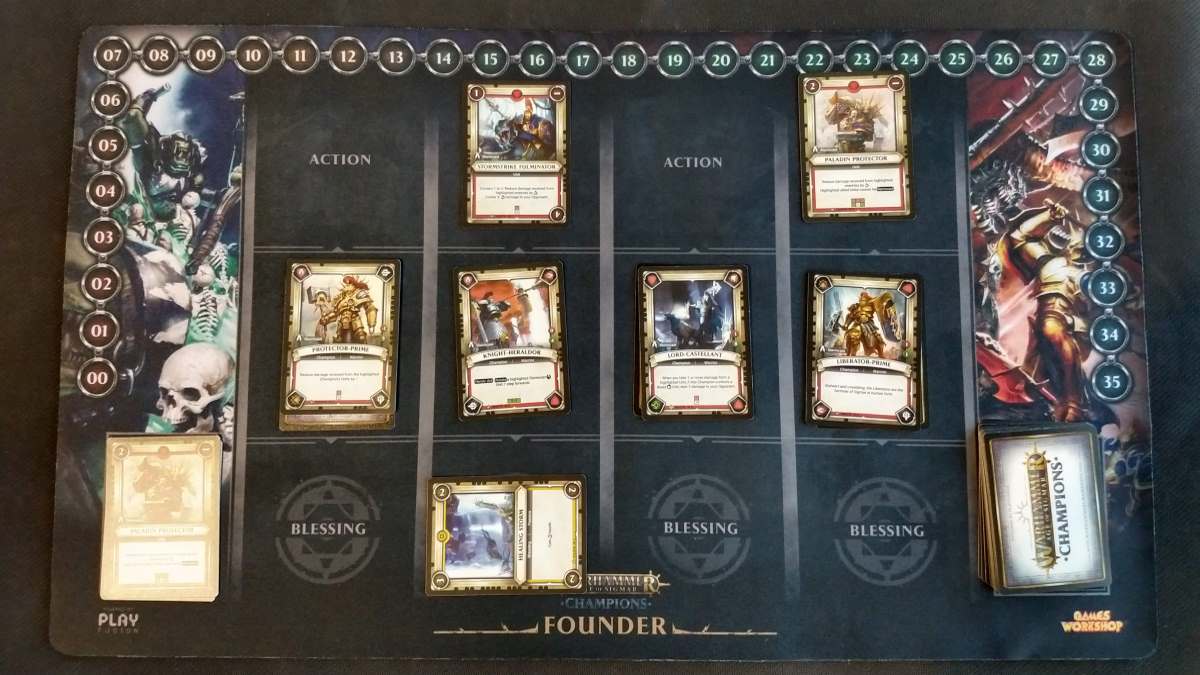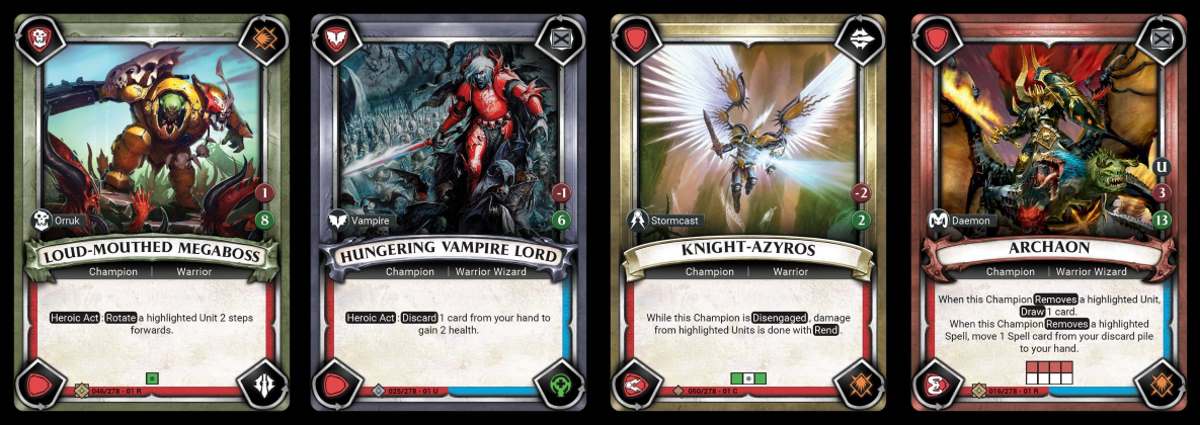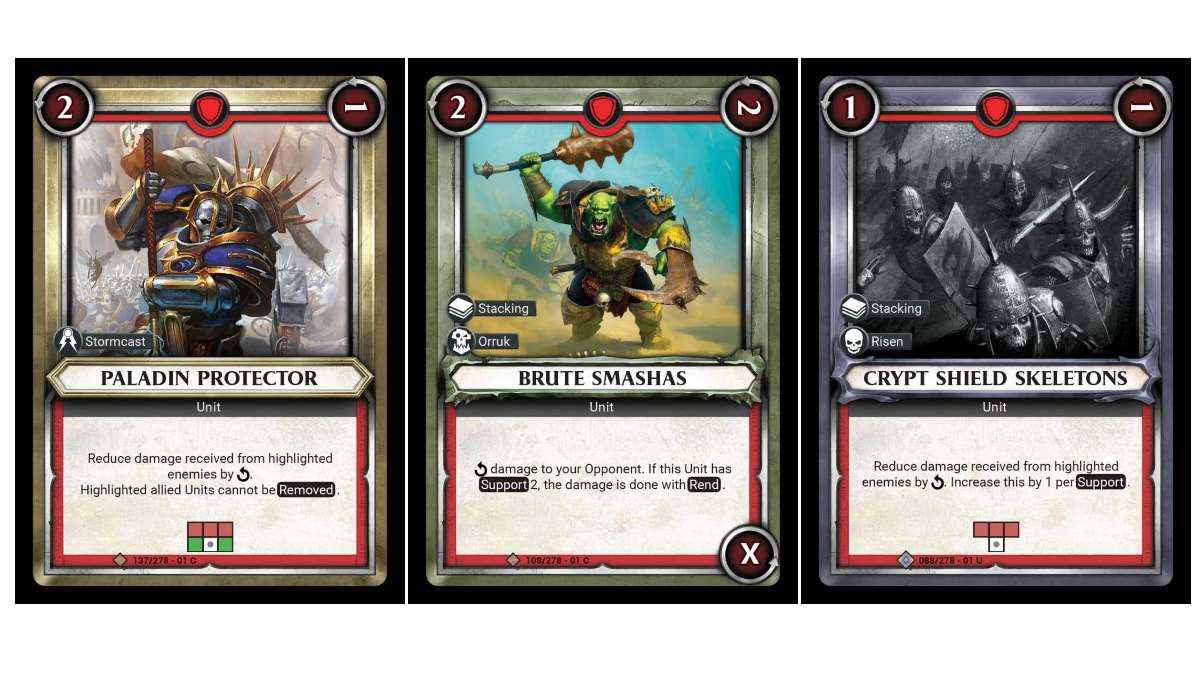 First, it took my money with metal. Then it took my money with plastic. Next, it took my money with cards AND plastic. Now Games Workshop is after my money with cards only, and this time its brought along a friend to hold me down. Warhammer Age of Sigmar: Champions is a quick-to-play trading card game, a collaboration between Games Workshop and Lightseekers designers PlayFusion. The match seems like a perfect marriage: strong artwork, a proven mechanic, a funky app to play online, and a loyal fanbase fanatical about collecting. Almost nothing can go wrong. But is Champions a quick cash-in or a worthy game in its own right?
First, it took my money with metal. Then it took my money with plastic. Next, it took my money with cards AND plastic. Now Games Workshop is after my money with cards only, and this time its brought along a friend to hold me down. Warhammer Age of Sigmar: Champions is a quick-to-play trading card game, a collaboration between Games Workshop and Lightseekers designers PlayFusion. The match seems like a perfect marriage: strong artwork, a proven mechanic, a funky app to play online, and a loyal fanbase fanatical about collecting. Almost nothing can go wrong. But is Champions a quick cash-in or a worthy game in its own right?
What is Warhammer Age of Sigmar: Champions?
It’s a trading card game for 2 players. Having a collectible/trading component brings with it a set of parameters unfamiliar to most GW players. Resource scarcity. Trading card games rely on blind boosters; it’s the model for pretty much all of them. The idea you can buy a foil packet of cards and not know what you’re going to find inside. The more cards you own the more chance the pack won’t contain anything you want. (Getting those last few is where the trading comes in.) As with Pokemon, Magic the Gathering, or Yu-Gi-Oh, cards have a rarity value, with commons being easier to find than rares (and cynically, rares being the ones you need to make the best deck).
Unlike recent addition to the Warhammer universe, Warhammer Underworlds, where all cards are equally available, the more you spend on Champions (arguably) the better cards you’ll have. There are pros and cons to both models. You could argue every Games Workshop game is pay to win. The more models you have (and the more you spent on them), the more chance you have of putting together a killer army.
The Warhammer Underworlds model sees the very best cards distributed across all of the available boxes. Yes, you always know what you’re going to get, but to remain competitive, you almost HAVE to buy everything. With Champions, every purchase is a mystery, and the cards you don’t need will inevitably pile up, with you the card you desperately want remaining tantalizingly elusive. Fortunately, even without a full set of cards, Warhammer Age of Sigmar: Champions is an entertaining game.
Where to start?
The easiest way into the game is via the starter boxes (the clue being in the name). These will give you a complete deck of cards required to play, a rules sheet, and paper playmat. After that, how many boosters you buy is up to you.
There are 4 different factions to play, based around factions from the parent Warhammer game: Order, Destruction, Death, and Chaos. When you choose a deck to play you are choosing a single faction. Which faction you wish to play determines which starter box you buy.
Each faction has its own play style, so you may wish to research before choosing. If you are familiar with the Age of Sigmar universe you know roughly what you’re going to get. The factions play to type. A complete card list is available here, should you want to take a look. Note: “Faction” in the Warhammer world is not the same as “army” or “race.” Cards with different races exist within factions and can be played alongside one another. (e.g. Aelf and Stormcast both come under the Order umbrella.)
The majority of cards in the game are faction specific—i.e. they can only be used when playing a particular faction, but there are some universal cards that can be used by any faction. A starter box contains the cards from one faction only, with a few “universal” cards thrown in.

Let’s assume you have your starter boxes (you’ll need two decks for a game) and get into the nuts and bolts of how to play.
How do you Play Warhammer Age of Sigmar: Champions?
These rules apply to the “constructed deck” format, which is fine for casual players. Tournament variations will follow. Check out the Champions website for more details.
Key concept 1
Unlike most Warhammer games, only you, the player, has “wounds” (health, life, hit points, whatever). Your champions/units, whilst they can be removed, aren’t damaged as such. There is only one score to keep track of, your “health.” Once that is reduced to zero, it’s game over. This is the only way to win/lose the game.
Key concept 2
Every deck has 38 cards: 4 Champions, 4 Blessings, and 30 Action cards.
Each of the 4 blessings must be unique. Champions do not have to be unique. (Though some Champions are marked with “U,” in which case you can only use one of them in a deck.) Each champion has a point score (given in a green circle); this translates roughly into how good they are. You may not have champions totaling more than 20 points.
Key Concept 3
The game takes place in 4 lanes. Each lane will contain a champion and a blessing for each player. Blessings are placed in secret and at random in each lane. Champions are then placed on top of them. Players take turns to place a champion face up, with turns being staggered so that nobody has the advantage of always playing their champion second.
Key Concept 4
Blessings are hugely powerful cards that can cause catastrophic damage to your opponents or valuable boons to your army. It’s in your interest to get them into play as early as possible. This introduces the concept of card “turning,” which is a core mechanic of the game.

Turning Champions
If you look at a champion card you’ll see a symbol in each corner. This denotes a quest to be completed. If you complete all four quests, you release the blessing that is underneath the champion. Quests MUST be completed in the correct order, starting with the quest in the top left-hand corner. Once that quest has been completed, the champion card is turned through 90°, placing a new quest in the top left corner. In order to release a blessing (i.e. complete all four quests), the card will have turned through 360°. After a blessing has been played there is no further need to rotate that champion.
How do I complete a quest?
This is where things start to get a little abstract. Your 30 action cards are played on or in front of a Champion. You choose which champion you want to use an action card with and play it in their track. Units usually stick around for a while and so are placed in front of Champion (at which point a Champion is said to be “engaged”). “Abilities” are one hit cards that resolve immediately, but again, you have to choose one of your champions (and the lane they are in) to play them on.
Quests are usually resolved as an effect of playing an action card from your hand. (See game sequence below.)
Typical quests are “Deploy a unit (an easy one),” “Deploy a particular type of unit,” “Cast a spell,” “Play an ability,” “Do damage,” “Heal,” and “Remove a unit or spell.”
Doing these things is usually easy. Doing them at the right time and right place, to further your ends, is a little more tricky.
NOTE: One action card may only complete one quest. So if you played an ability card to fulfill your first quest, your champion card would rotate. If the card’s second quest was “do damage” and the ability card you played did damage, you CANNOT rotate the card a second time. However, if the ability card enabled you to deploy a unit, and that unit subsequently did damage, this would fulfill the second quest corner, as it uses a different card to the one used to complete the initial quest.
In a nutshell then:
- Reduce opponents to zero health to win the game.
- Each deck has four unique blessings.
- Each deck has 4 champions with 4 quests.
- Completing a champion’s 4 quests releases a blessing that was placed randomly at the start of the game.
How does a game of Champions work?
The turn quest corners to reveal blessings is a beguiling preamble, but it won’t actually win you the game. To do that you need to do some damage, and you do that, mostly, with your action cards. These are split into 3 types.
- Units (Usually Red)
- Spells (Usually Blue)
- Abilities (Can be Red or Blue or colorless)
As a general rule, only Warriors (red cards) can place units and Wizards (blue) cast spells. Abilities that are colorless can be played by either, with the caveat that a Wizard currently with an active spell may not use abilities.
After blessings and champions have been placed, players then draw from their 30 card action deck. Player 1 will draw four cards and player 2 five.
Key concept 5
Common to most CCGs, text written on cards supersedes text written in the rules (and therefore some cards can cause exceptions to the outline I’m laying out here).
Key Concept 6
The first thing a player does with his turn is attend to his active units and spells. This is called the Battlefield phase. As there will be no active cards in the first turn, I’ll pass over this for now and pick it up in a moment.
Key Concept 7: The Action Phase
Players may play cards during the Action Phase and (normally) may use up to 2 actions in their turn. An action is playing an action card. After a player uses 2 actions, play passes back to their opponent. You do not have to play two actions, you can play 1 and pick up a new card, or none and pick up 2 new action cards. You MUST play any actions before picking up. i.e. You cannot skip your first action to pick up a card and then play an action card.
Remember if an action fulfills one of your champions quests, you can rotate the champion card through 90°.
Note some cards and abilities allow you to gain additional actions, which means you may be able to keep playing actions and draw cards. 
Key Concept 8. The anatomy of a card
There is quite a lot going on with an action card.
The border color denotes which faction a card belongs to. Red is Chaos. Note the interior brighter red border. This indicates the card is playable by a warrior. The small text in the center of the card explains what a card does. The 3/4 circle arrow in the text, denotes the corner of the card and always pertains to the corner in the top left.
When a card is played you immediately resolve its first corner.
With the Blood Warrior Berserker, above, the X has a very specific meaning. Namely, that the card text is treated as blank. i.e the card does nothing. As the first corner is used when a card is put into play, the card would do nothing when first played. If the X and the 1 had been swapped around, the card would immediately do one damage when put into play. Remember all damage is scored directly against an opponent’s health.
Some card abilities have area of effects denoted by an array of little boxes at the bottom of the card, either green or red. The text is usually written as “units highlighted by”. Green boxes mean they affect your cards and red your opponent’s. So in the case of the Blood Warrior Berserker, nothing happens on the first turn, but on subsequent turns, in addition to doing damage against your opponent, the card also boosts cards in the spaces to the left and right. (Given by the green boxes either side of the white box with the dot in.)
There are a few more examples below of other unit cards.
The cards below also display a couple of other card properties. Unit types “Stormcast” or “Orruk.” Some abilities only affect certain types of card. If an effect only works on Orruk cards, any cards that don’t have the Orruk tag would be unaffected. Some cards also have special rules, such as Stacking or Rend. These are additional attributes that a card has. I’m not going to run through all the available types. You can check them out in the official rules pdf.
The Battlefield Phase in More Detail
Once the first two Action phases of the game have been played, it will be the start of the game’s second turn. More likely than not there will now be unit cards in play. Starting from the left-hand side, the player whose turn it is rotates each of their units and/or spells in play through 90°, resolving the effect of the new corner each time they turn the card. In the case above with the Blood Warrior Berserker, the card would now do one damage and its ability to boost damage would be activated.
On this player’s next turn, the card would be turned again, the damage it causes AND its damage boost would increase to 2. Many cards increase potency each time they turn. On the Beserker’s third rotation we come to an empty corner. At this point, the card is removed to the discard pile. Note: If there are corners that have circles or have circles with an X in, the cards are not removed. In the case of empty circles, any interior text still applies. In the case of an X. The card does nothing. It is merely blocking a space that turn. Once a card has been rotated through 360° it is always removed. You don’t keep turning ad infinitum.
Cards are always rotated clockwise, though some effects enable you to turn them back a step, which can be very useful. Some card abilities enable you to rotate cards additional times outside of the battlefield phase. If you do this, the effects of the card are applied for each turn of the card.
Cards all always rotated in order left to right as you look at your player mat. You can see why this is important when looking at the Blood Warrior Berserker. This card affects cards to the left and right of it. Before it has been turned the first time, it won’t boost the card to its left (because the card to its left will be invoked before the Berserker’s ability has been switched on).
The Berserker will, however, turn to its second corner before any card that is to its right. This means the Berserker’s abilities are now invoked. When the battlefield phase moves onto the next card to the Berserker’s right, that card may take any boost offered by the Berserker card. Similarly, on its final turn, the Berserker will boost the card to the left, but after it’s rotated and removed, it will no longer boost the card to the right.
Playing Spells
Spells (blue cards) work is pretty much in the same way as units. They can only be used by blue champions and they turn in the battlefield phase in exactly the same way as Units.

Ability Cards
Ability cards are a little different. These are one-shot cards. They are played in a Champion’s lane and have a variety of effects depending on the card used. There are red, blue, and colorless cards, which can be played by warriors, wizards, or anybody, respectively. They may affect your opponent’s cards or yours or they may deal direct damage to your opponent or possibly heal you. Ability cards are often crucial in turning champion cards as they provide a variety of effects that may not be readily available from your units.
Repeat until dead
The game then continues in this way with player turns alternating after each Action phase until one of the players is reduced to zero hit points. At which point the game immediately ends.
There’s an app for that.
Warhammer Age of Sigmar: Champions was created by PlayFusion, a team of developers who make games that have physical and digital components, though the two media don’t combine. You either play physically in person or online with friends or strangers through the random matchup function. The digital game is available for Android, iOS, and Amazon.
Any cards you buy physically can be digitally scanned within the app, allowing you to recreate your physical hands inside the digital game. You can also earn rewards and (of course) buy digital boosters that will supplement your digital collection whilst doing nothing for those you have in the physical world.
Inside the app, you can play games against an AI opponent or for a more challenging experience against other humans. The game is good fun to play and faster than its physical counterpart because the app works out all the damage and modifiers for you. It can be a little bewildering at first because games can move very quickly. I recommend playing some AI opponents first. The app will let you look at every card in the game during play, so you can always see what a given card does at any time. It also keeps track of how many actions you have left and which units are affected by a particular action. Essentially, it does all the bookkeeping for you.
The app also has full deckbuilding capabilities, again making sure your decks are legal, and allows you to experiment with different ideas for improving the playability of your cards.
If you’re going to play the Champions, you are definitely going to want to play it online too. As well as matches and deckbuilding there are challenges are rewards too. At the time of writing Ranked play has been added too.
Be sure to look out for the shareable cards that come in physical boosters, scan them into the app, and share them with your friends (or random strangers in the devoted Facebook group). The more your cards get scanned by other people the more you can unlock exciting online content. It’s worth noting at this point, that if you do share any physical cards online before you’ve scanned them into the app, somebody else could potentially scan your photo, thus giving themselves your digital cards. Scan before you post!
What is Warhammer Age of Sigmar: Champions like to play?
There are definitely two approaches to playing Champions. It’s a competitive collectible card game. As such, it attracts some competitive card players, who are always looking for the inside track and the best combos.
The game, however, is very forgiving. Whilst it is possible to be annihilated by somebody who has power-built their deck, nearly every game I’ve played has been close. This is despite my not having had much chance to tinker with my deck to make it strong. Like many TCGs, if you want to be ultra-competitive, you’ll need to hunt down as many cards as possible. Nevertheless, for casual players, the game is still great fun and well-balanced even if you only buy a couple of starter boxes and some extra boosters. The game doesn’t have to break the bank.
The initial card base is still quite small, which makes it a good time to get involved. There aren’t yet a bewildering array of options and cards for your opponents to bamboozle you with. The additional possibilities of playing within the app make it easy to get playing straight away.
Whilst the core of the game is simple (cards go in four lanes, win by doing damage to your opponent), the turning of the cards and the ever-shifting nature of their abilities can make the game confusing at first. That said, once you actually sit down and play a couple of hands, things rapidly become clear. Champions is remarkably intuitive. My boys (9 and 12) picked it up very quickly. The 12-year-old even teaching the 9-year-old in my absence.
A Warhammer World of Possibilities
Fans of the Warhammer: Age of Sigmar universe will surely love the card art and the look and feel of the game. It captures the AoS setting perfectly, without the need for boxes of plastic and hours of painting; sometimes that’s exactly what a time-pressed hobbyist needs. The card quality is excellent. Much better, I think, than the Warhammer Underworlds cards. Champions feels like a quality product.
From the 270 or so cards available, it’s possible to build a great many deck types for the game. Even within a faction and drawing from a smaller pool, there are many ways to build your deck. How much time you want to spend doing this probably comes down to personal preference.
When playing the game, again there are lots of possibilities and the mechanics are delicately balanced. There’s a constant tussle between drawing cards and playing cards, as both actions compete for those precious two action slots (Destruction decks have ways of generating more actions, which are invaluable). The challenge of the game is managing your resources.
Ensuring your Champions are in the right place to maximize their effectiveness without being adversely affected by your opponent’s abilities can be tricky. Timing and positioning of units and spells can be vital. Powerful cards can take three or four turns before unleashing their devastation, which is lots of time for your opponent to come up with ways of defeating them. The damage from less powerful cards is easily blocked but these cards deliver their payload earlier. It’s all a balancing act, and I have to say, one I’m not very good at!
Games of Champions are over in roughly 20 mins and are fun to play. PlayFusion has done their homework and created a game that captures the essence of the Warhammer tabletop experience and packaged it into a game of only 38 cards. That’s no mean feat. Initial take-up of the game has been strong and it has a lively, passionate, and very friendly online community. With huge amounts of the Warhammer universe still unrepresented, there is still plenty of room for expansion and new cards. On the strength of this initial release, I see Age of Sigmar: Champions continuing for several seasons at least, drawing in players Age of Sigmar novices and veterans alike.
![]() To subscribe to GeekDad’s tabletop gaming coverage, please copy this link and add it to your RSS reader.
To subscribe to GeekDad’s tabletop gaming coverage, please copy this link and add it to your RSS reader.
Click here to see all our tabletop game reviews.
Disclosure: GeekDad received a copy of this game for review purposes.



